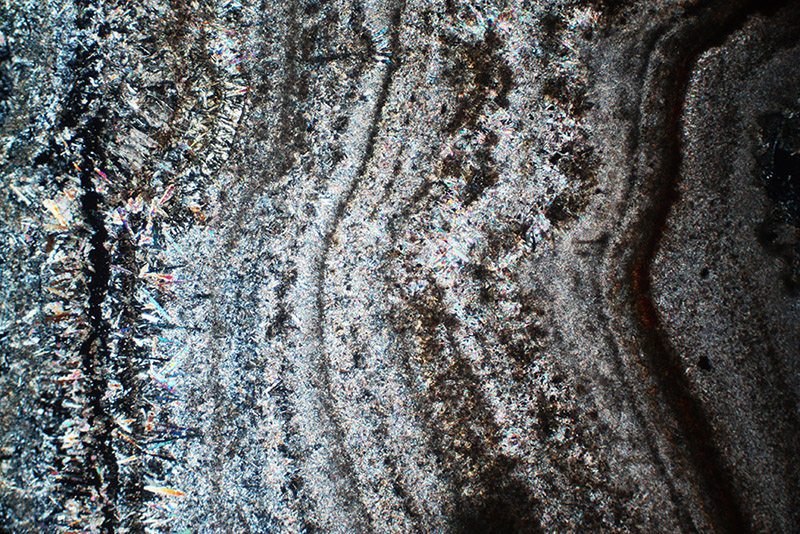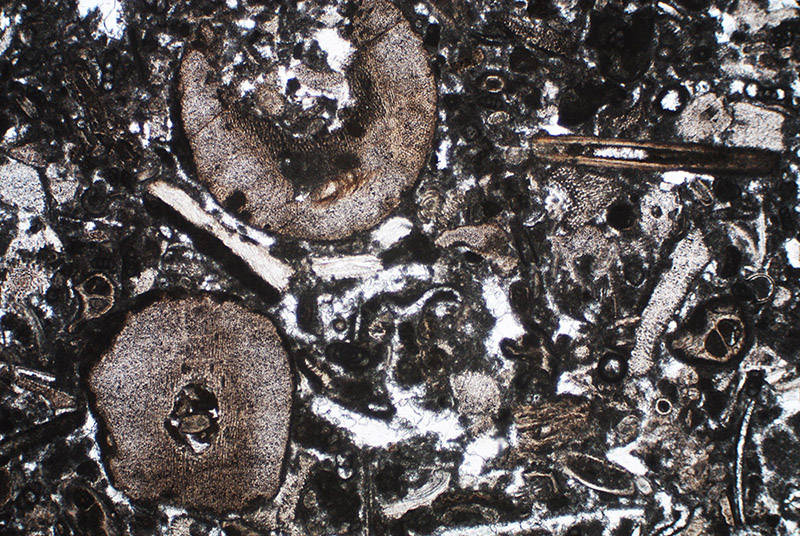Thomas Henderson, 1824-1906
“T.H.”
by Brian Stevenson
last updated October, 2020
There are a good number of microscope slides that have the initials “T.H.” handwritten on the labels (Figures 1 and 2). The majority of these slides are high-quality thin sections of minerals, mostly naturally-occurring rocks and fossils. Some are of unusual mineral subjects, such as “boiler fur”, i.e. lime deposits from the insides of boilers of engines used for steam power. A thin-section of coal by T.H. is illustrated in Brian Bracegirdle’s Microscopical Mounts and Mounters, Plate 42-G. The maker dated the slides, ranging from the late 1880s through the first decade of the 1900s.
Three “T.H.” slides are known that are made of wood, rather than glass, and contain the name “T. Henderson” stamped into the wood (Figure 2).

Figure 1.
A sampling of microscope slides that bear the handwritten initials “T.H.”. The maker regularly put a backwards flourish at the bottom of vertical lines - note the “T” in Tormore Shore and “I” in I. Arran on the second slide on the right - showing that the first initial is a “T” and not a “J”. Brian Bracegirdle’s Microscopical Mounts and Mounters shows a papered microscope slide by T.H. in Plate 42-G.

Figure 2.
One of three known wooden slides that have “T.H.” on the label and “T. Henderson” stamped into the wood. Thomas Henderson was a professional woodworker, and probably shaped the wood himself.
It has been a complex hunt to identify “T. Henderson”. I have not found any records of this person being a member of a scientific society, or advertising specimens for sale or exchange (although, given the number of “T.H.” slides that have survived, and those marked with his full surname, I suspect that the maker regularly met and exchanged slides with colleagues who were also interested in mineralogy and/or microscopy).
An important clue was provided by an 1895 publication in Science-Gossip by W.W. Midgley, who described microscopical examinations of thin-sectioned pine wood fossils. He stated that “The sections were cut from one of the specimens in our museum by Mr. T. Henderson, of Dunston-on-Tyne”. Midgley’s lapidary mounts are consistent with T. Henderson’s known microscope slides. Several of Henderson’s slides note that specimens were acquired in or near Dunston (e.g., see Figures 1 and 4).
That information led to discovery of a 1902 book by one J.W. Fawcett, Tales of Derwentdale, that includes a list of subscribers in the back (i.e. people who pre-paid for the book, thereby funding its publication). Among these is “Henderson, Thomas, Dunston House, Dunston-on-Tyne”.
A search of the 1901 census of England revealed that Thomas Henderson, a 76 year-old “joiner carpenter”, lived at Dunston House with his daughter, Elizabeth Dotchin, and her husband and children. The census also recorded that Henderson was born ca. 1824 in Northumberland.
Working back through the censuses showed that Thomas Henderson had previously lived in Scotswood, Northumberland from at least 1851 through 1891. That confirmed that he was the man who had donated fossils to the Natural History Society of Northumberland, Durham, and Newcastle-upon-Tyne: “A specimen of Lepidodendron, from Fire Clay Drift, Scotswood, and a specimen of Stigmaria, from the Beaumont Seam, Montague Colliery. Mr. Thomas Henderson, Scotswood” (in 1867), “Specimens of Pennatula phosphorea? Naples; Alcyoniun palmata, Mediterranean; Corallium rubrum, Mediterranean; Synapta rosea, Jersey. Mr. Thos. Henderson, Scotswood” (1888), and “Marsupites and Echini, from the Chalk at Aldershot, and two Bivalves, from a well in London Clay. Mr. Thos. Henderson, Scotswood” (1890).
Thomas Henderson was recorded as working as a “joiner at brick yard” in the 1881 census. This occupation would have given him ample access to the brick yard “boiler fur” that he often mounted on microscope slides (Figures 1 and 4).
Altogether, the evidence shows that slide-maker “T.H.” / “T. Henderson” was the Thomas Henderson who lived in the Scotswood / Dunston area along the River Tyne. He had a strong interest in minerals, fossils, and natural history, and was an acclaimed mounter of thin-sectioned mineral specimens.
Thomas Henderson was born on September 3, 1824, in Ovingham, Northumberland, son of Thomas and Mary Henderson. His father worked as an “agricultural laborer”, according to the 1841 census.
The 1841 census shows that young Thomas was working as a “joiner”, presumably an apprentice, considering his age. He continued at that profession throughout his life. As noted above, the 1901 census listed that he was still working when 76 years old.
Henderson married a woman named Mary Ann, probably Mary Ann Mordue, in 1848. They had two children, John and Jane. Mary Ann died in 1856 or 1857 (women named Mary Ann Henderson died in the area during each of those years.
Henderson then married Elizabeth Halliday in the spring of 1858. Thomas had four additional children with Elizabeth. She died in the mid-1890s. Thomas then went to live with a daughter, as noted above. He died during late 1906.

Figure 3.
Although the majority of his known slides are of mineral subjects, Thomas Henderson mounted a variety of other specimens. This mount of grizzly bear hair was prepared in 1900. Photographed with a 3.5x objective lens, a C-mounted digital SLR camera, and crossed polarizing filters.

Figure 4.
“Boiler fur, brick works, Dunston”, prepared in 1900 by Thomas Henderson (see Figure 1). Photographed with a 3.5x objective lens, a C-mounted digital SLR camera, and crossed polarizing filters.

Figure 5.
“Fossil ferns, calciferous sandstone, Aberdeen”, prepared in 1889 by Thomas Henderson (see Figure 1). Photographed with a 3.5x objective lens, and a C-mounted digital SLR camera.

Figure 6.
“Foram & spines, Hunleyside limestone, Allendale”, prepared in 1894 by Thomas Henderson (see Figure 1). Photographed with a 3.5x objective lens, and a C-mounted digital SLR camera.
Resources
Bracegirdle, Brian (1998) Microscopical Mounts and Mounters, Quekett Microscopical Club, London, pages 51, 93 and 188, and Plate 42-G
England census and other records, accessed through ancestry.com
Fawcett, J.W. (1902) Tales of Derwentdale, R. Jackson & Co.
Midgley, W.W. (1895) Fossil pine, Science-Gossip, New series, Vol. 2, page 2
Natural History Transactions of Northumberland and Durham (1867) Donations, page 276
Natural History Transactions of Northumberland and Durham (1888) Donations, page 175
Natural History Transactions of Northumberland, Durham, and Newcastle-on-Tyne (1890) Donations, page 177





